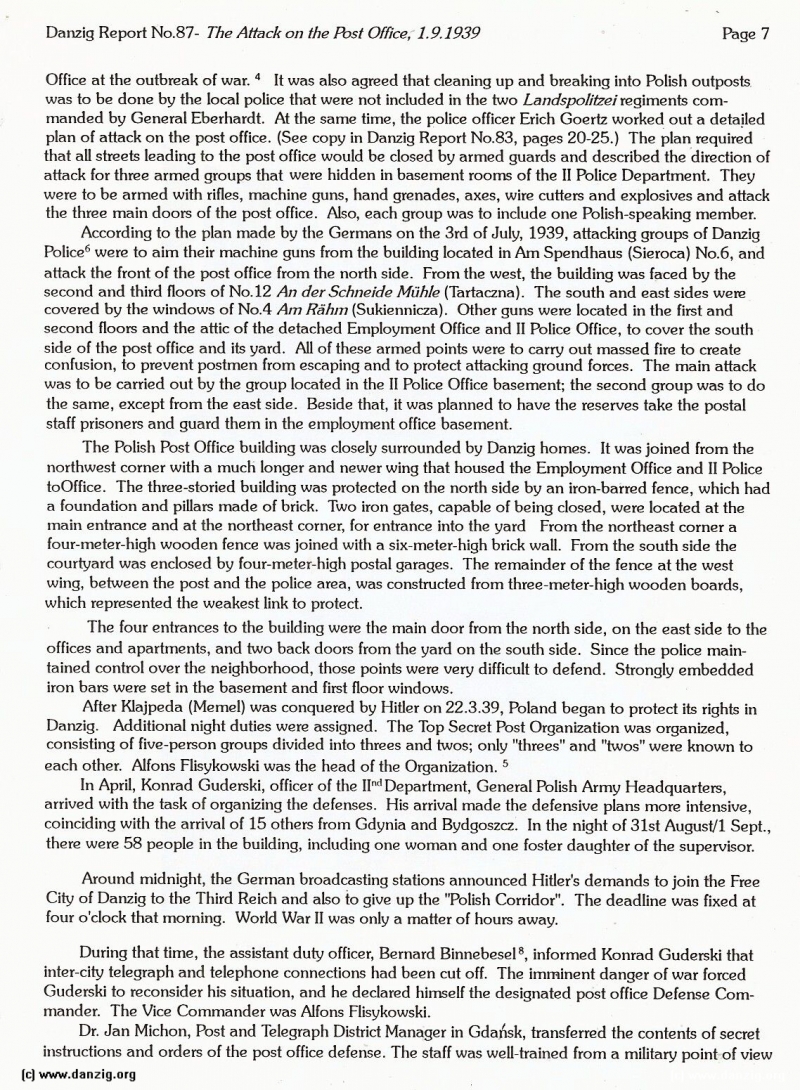
> The Attack on the Post Office
Office at the outbreak of war. It was also agreed that cleaning up and breaking into Polish outposts was to be done by the local police that were not included in the two Landspolitzei regiments comm anded by General Eberhardt. At the same time, the police officer Erich Goertz worked out a detailed plan of attack on the post office. (See copy in Danzig Report No.83, pages 20-25.) The plan required that all streets leading to the post office would be closed by armed guards and described the direction of attack for three armed groups that were hidden in basement rooms of the II Police Department. They were to be armed with rifles, machine guns, hand grenades, axes, wire cutters and explosives and attack the three main doors of the post office. Also, each group was to include one Polish-speaking member.
According to the plan made by the Germans on the 3rd of July, 1939, attacking groups of Danzig Police6 were to aim their machine guns from the building located in Am Spendhaus (Sieroca) No.6, and attack the front of the post office from the north side. From the west, the building was faced by the second and third floors of No. 12 An der Schneide Mühle (Tartaczna). The south and east sides were covered by the windows of No. 4 Am Rabin (Sukiennicza). Other guns were located in the first and second floors and the attic of the detached Employment Office and II Police Office, to cover the south side of the post office and its yard. All of these armed points were to carry out massed fire to create confusion, to prevent postmen from escaping and to protect attacking ground forces. The main attack was to be carried out by the group located in the II Police Office basement; the second group was to do the same, except from the east side. Beside that, it was planned to have the reserves take the postal staff prisoners and guard them in the employment office basement.
The Polish Post Office building was closely surrounded by Danzig homes. It was joined from the northwest corner with a much longer and newer wing that housed the Employment Office and II Police to Office. The three-storied building was protected on the north side by an iron-barred fence, which had a foundation and pillars made of brick. Two iron gates, capable of being closed, were located at the main entrance and at the northeast corner, for entrance into the yard From the northeast corner a four-meter-high wooden fence was joined with a six-meter-high brick wall. From the south side the courtyard was enclosed by four-meter-high postal garages. The remainder of the fence at the west wing, between the post and the police area, was constructed from three-meter-high wooden boards, which represented the weakest link to protect.
The four entrances to the building were the main door from the north side, on the east side to the offices and apartments, and two back doors from the yard on the south side. Since the police maint ained control over the neighborhood, those points were very difficult to defend. Strongly embedded iron bars were set in the basement and first floor windows.
After Klajpeda (Memel) was conquered by Hitler on 22.3.39, Poland began to protect its rights in Danzig. Additional night duties were assigned. The Top Secret Post Organization was organized, consisting of five-person groups divided into threes and twos; only “threes” and “twos” were known to each other. Alfons Flisykowski was the head of the Organization.
In April, Konrad Guderski, officer of the IInd Department, General Polish Army Headquarters, arrived with the task of organizing the defenses. His arrival made the defensive plans more intensive, coinciding with the arrival of 15 others from Gdynia and Bydgoszcz. In the night of 31st August/1 September, there were 58 people in the building, including one woman and one foster daughter of the supervisor.
Around midnight, the German broadcasting stations announced Hitler’s demands to join the Free City of Danzig to the Third Reich and also to give up the “Polish Corridor”. The deadline was fixed at four o’clock that morning. World War II was only a matter of hours away.
During that time, the assistant duty officer, Bernard Binnebesel, informed Konrad Guderski that inter-city telegraph and telephone connections had been cut off. The imminent danger of war forced Guderski to reconsider his situation, and he declared himself the designated post office Defense Comm ander. The Vice Commander was Alfons Flisykowski.
Dr. Jan Michon, Post and Telegraph District Manager in Gdansk, transferred the contents of secret instructions and orders of the post office defense. The staff was well-trained from a military point of view.
Danzig Report Nr. 87 - April - May - June - 1995, Page 7.
Hits: 4663
Added: 11/07/2015
Copyright: 2026 Danzig.org

